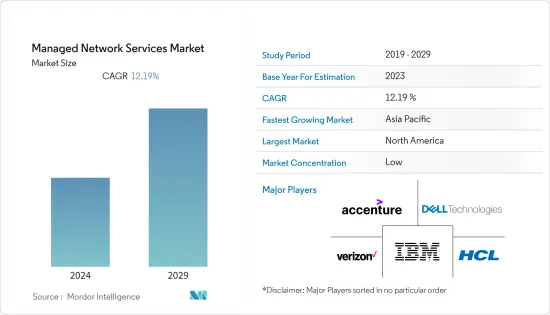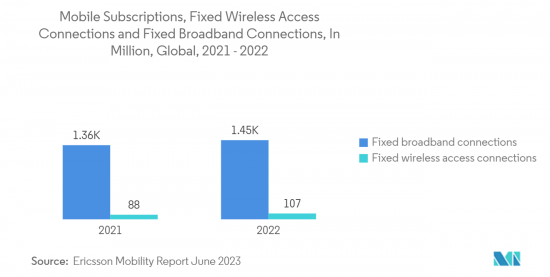PUBLISHER: Mordor Intelligence | PRODUCT CODE: 1403931

PUBLISHER: Mordor Intelligence | PRODUCT CODE: 1403931
Managed Network Services - Market Share Analysis, Industry Trends & Statistics, Growth Forecasts 2024 - 2029

The managed network services market was valued at USD 79.69 billion in the previous year, and it is expected to record a CAGR of 12.19%, reaching USD 149.28 billion over the forecast period. Increasing business process efficiency by cost optimization and high penetration of mobility, cloud computing, and big data technology are some of the major factors driving the market growth.
Key Highlights
- Managed network services give SMEs much space to grow and achieve their goals. IT spending among SMEs is anticipated to rise, demonstrating that SMEs constantly focus on expanding through implementing new and extended IT services. The demand for managed network services is increasing as SMEs increasingly adopt cloud computing, automate services, and experiment with advanced digital technologies.
- The growing digital transformation propels the demand for managed network services as they provide expertise, scalability, security, and operational efficiency in managing complex and critical networks that underpin modern businesses. According to a Global Network survey by NTT Group, about 93% of organizations recognize the significance of the network as the backbone of digital transformation.
- With a modern hyper-distributed workforce, customers' networking and security requirements are evolving as more employees use the network from various places and devices. Organizations are searching for solutions and services to handle these difficulties to serve the new and highly scattered workforce, providing opportunities for the managed network service providers.
- The alarming growth in cybercrimes has worried organizations about the potential risks associated with outsourcing network management, including exposing confidential information to third parties. High-profile data breaches or security incidents involving managed service providers can exacerbate these concerns and lead some businesses to hesitate in adopting the managed network service market.
- The COVID-19 crisis created an unprecedented situation for MSPs on a global level. As businesses adjusted to rapidly changing work environments, the quality of collaboration and communication profoundly impacted both productivity and employee output. This resulted in increased demand for managed network services from businesses so that employees had seamless access to their workplace apps on the device they used, whether personal or company-owned.
Managed Network Services Market Trends
IT and Telecom Sector to be the Largest End User
- Modernizing IT service management for the IT and telecommunications sectors is quite a mature methodology. This bridges the gap between on-premise and cloud-based IT solutions. It improves operational effectiveness and efficiency. As a result, integrating how data is recorded, processed, and shared across companies enhances the experience for internal IT personnel and external constituents.
- With the rapid growth of technology, telecommunication companies are constantly concentrating on innovation. As a result, they are enhancing their infrastructure while providing advanced solutions to support their clients, such as innovation, customer service, infrastructure configuration, and human resources.
- The increased adoption of 5G networks is the current market trend. Mobile network operators handle the increasing complexity caused by implementing 5G and the requirement for dependable, secure, and robust connections. The increased number of devices, a diversity of new technologies, and a broader spectrum of service requirements drive this complexity. As the 5G usage cases become more sophisticated, demanding, and vital, secure user experience has become the primary end-user expectation.
- When 5G networks are planned, developed, built, and implemented, the emphasis shifts to supporting end users' whole security and quality experience. This further necessitates a fundamental shift in how deployed networks are managed and optimized.
- To successfully operate high-performance service-driven networks securely and depart from the traditional network resource management model, where technology-related capacity, availability, and performance are critical, the 5G network operations and optimization require a shift from technology-centric to end-user service-centric. As a result, there is an increase in the demand for telecom-managed services to help with this transition, thereby driving the market revenue growth. According to Ericsson Mobility Report, June 2023, the growth in 5G subscriptions is expected to continue into the foreseeable future, reaching 1.5 billion subscriptions globally by the end of the year, which includes an increase of 500 million subscriptions in the past one year.
- Various players across the world are undertaking various initiatives as a move toward the adoption of managed services. Large enterprises segment has emerged to be a growing segment in the market. Companies are making significant efforts to offer enhanced managed services.

Asia Pacific Holds a Dominant Position in Managed Network Services Market
- The managed network services market in the Asia-Pacific (APAC) region is expanding due to several key factors. The demand for managed network services is driven by rapid digital transformation, rising penetration of mobile devices and the Internet, growing e-commerce, and a need for reliable high-speed connectivity. Some companies seek to integrate new digital technologies into the digital revolution movement. As firms continue to invest in digital transformation, every company has enlisted the help of a managed network services provider.
- APAC businesses recognize the benefits of network management to ensure efficient operations and robust cybersecurity, fueling the growth of the market.
- Several market players are involved in numerous strategies to gain a competitive edge, further fueling the demand for Managed Network Services. In June 2023, at Mobile World Congress Shanghai 2023 (MWCSH 2023), Huawei launched a product and solution innovation and practice sharing event. During this event, the company shared the latest innovations and practices with its digitally managed network solution in the data communication field, aiming to help carriers transform from Internet service providers to managed service providers and capture new opportunities in digital transformation, thereby driving the growth of the market.
- By end user, the manufacturing segment is expected to grow. The manufacturing sector in the region has recorded a tremendous digital revolution in recent years. The Chinese government has actively supported digital technologies in traditional manufacturing processes to increase production efficiency and encourage innovation.
- With growing digital transformation, the need for reliable and high-speed connectivity, safeguarding digital operations, and complying with regulatory standards, along with the developments by the market players, are expected to drive the growth of the market in the region.
Managed Network Services Industry Overview
The managed network services market is fragmented with small players and dominated by major players, such as IBM Corporation, HCL Technologies Limited, Dell, Verizon, Accenture PLC, and others, with a strong client base. These players are constantly providing increased and enhanced offerings, along with newer expansions, partnerships, and acquisitions; the level of market penetration is favorable to the market, and it is providing major competitiveness.
- August 2023: Verizon Business formed a strategic global partnership, making HCLTech its primary Managed Network Services (MNS) collaborator in all networking deployments for global enterprise customers. HCLTech and Verizon bring together Verizon's networking strength, solution offering, and scale, and HCLTech's market-leading Managed Service offerings to create a new era for large-scale, wireline service provision for enterprise customers.
- October 2022: Accenture and Google Cloud announced an extended global partnership, reaffirming its commitment to growing its talent-enhancing joint capabilities, creating innovative data and AI solutions, and providing robust support to assist clients in establishing a solid digital foundation and transforming their businesses in the cloud.
Additional Benefits:
- The market estimate (ME) sheet in Excel format
- 3 months of analyst support
TABLE OF CONTENTS
1 INTRODUCTION
- 1.1 Study Assumptions and Market Definition
- 1.2 Scope of the Study
2 RESEARCH METHODOLOGY
3 EXECUTIVE SUMMARY
4 MARKET INSIGHTS
- 4.1 Market Overview
- 4.2 Industry Attractiveness - Porter's Five Forces Analysis
- 4.2.1 Bargaining Power of Suppliers
- 4.2.2 Bargaining Power of Consumers
- 4.2.3 Threat of New Entrants
- 4.2.4 Threat of Substitutes
- 4.2.5 Intensity of Competitive Rivalry
- 4.3 Impact of COVID-19 on the Macroeconomic Trends in the Market
5 MARKET DYNAMICS
- 5.1 Market Drivers
- 5.1.1 Lack of in-house Expertise
- 5.1.2 Benefit of Extensive Focus on Core Operations
- 5.1.3 Cost Benefits and ROI Achieved through Managed Services
- 5.2 Market Challenges
- 5.2.1 Organizations Remain Reluctant to Outsource Key Operations
- 5.3 Ecosystem Analysis
- 5.4 Analysis of Pricing Model
- 5.4.1 Managed Network Services Pricing Model
- 5.4.2 Case Studies for Pricing Determination
- 5.4.3 Pricing Details of Hardware by Network Equipment Providers
- 5.4.4 Analysis of Pricing and Pricing Model of Network as a Service (NaaS)
- 5.5 Key Use Cases
- 5.6 Networking Equipment Trends
- 5.6.1 Overall Market Estimates for Different Network Equipment (Routers, Switches, Servers, Network Security Equipment, Etc.)
- 5.6.2 Market Trends and Developments
- 5.6.3 List of Major Vendors Providing Network Equipment
6 MARKET SEGMENTATION
- 6.1 By Type
- 6.1.1 Managed LAN
- 6.1.2 Managed WAN
- 6.1.3 Managed Wi-Fi
- 6.1.4 Managed Network Security
- 6.1.5 Other Services
- 6.2 By Organization Size
- 6.2.1 Small and Medium Enterprises (SMEs)
- 6.2.2 Large Enterprises
- 6.3 By End User
- 6.3.1 BFSI
- 6.3.2 IT and Telecom
- 6.3.3 Healthcare and Pharmaceutical
- 6.3.4 Retail
- 6.3.5 Manufacturing
- 6.3.6 Education
- 6.3.7 Others (Utilities, Media, Etc.)
- 6.4 By Geography
- 6.4.1 North America
- 6.4.2 Europe
- 6.4.3 Asia-Pacific
- 6.4.4 Middle East and Africa
- 6.4.5 Latin America
7 COMPETITIVE LANDSCAPE
- 7.1 Market Share Analysis
- 7.2 Company Profiles
- 7.2.1 IBM
- 7.2.2 HCL Technologies Limited
- 7.2.3 Dell
- 7.2.4 Verizon
- 7.2.5 Accenture PLC
- 7.2.6 TCS
- 7.2.7 Wipro
- 7.2.8 Lumen Technologies
- 7.2.9 Cato Networks
- 7.2.10 NTT Group




